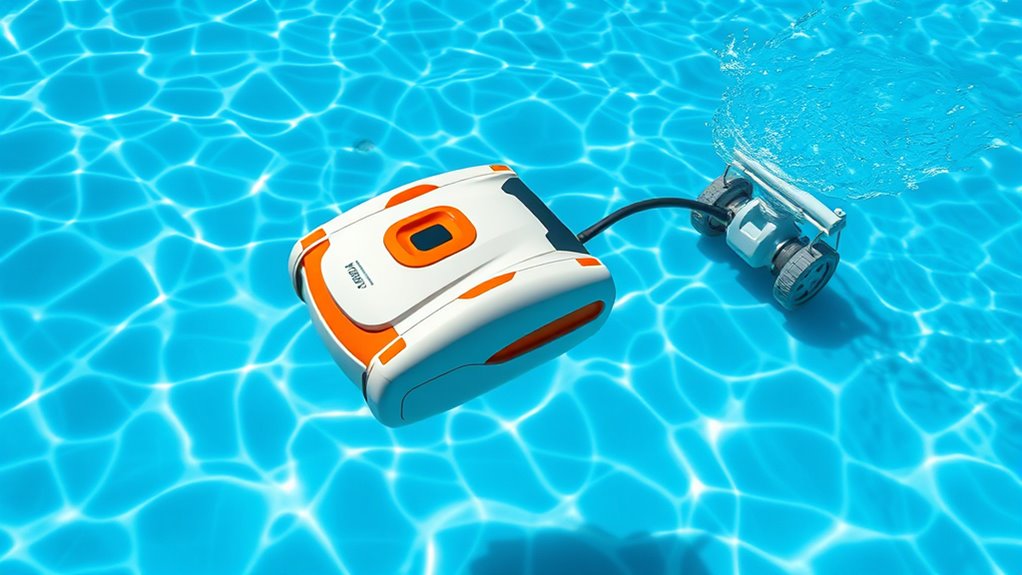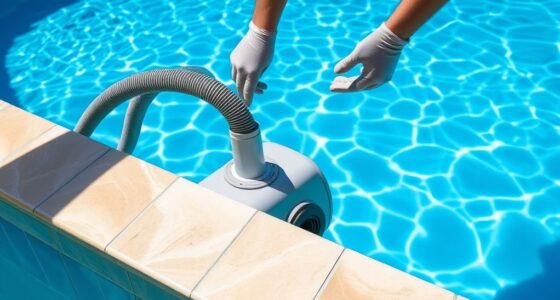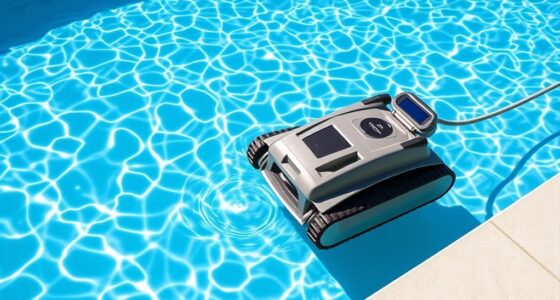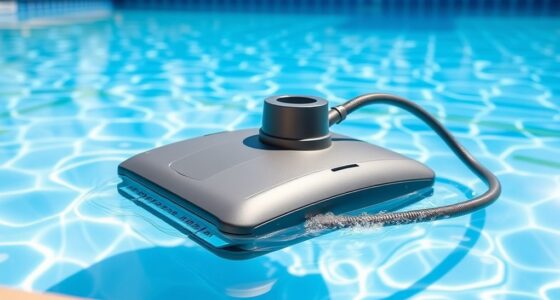Pressure pool cleaners use water pressure from your pool’s pump to move and clean, covering large areas quickly but missing corners. Robotic cleaners operate independently with their own motors, offering thorough cleaning and better filtration. While robotic models tend to cost more upfront, they’re easier to maintain and eco-friendlier. Depending on your pool size and maintenance needs, each has pros and cons—continue to explore which suits you best.
Key Takeaways
- Robotic cleaners operate independently with onboard motors, while pressure cleaners rely on pool pump water pressure.
- Robotic models offer thorough cleaning and better navigation, whereas pressure cleaners cover large areas quickly.
- Robotic cleaners tend to be more energy-efficient and eco-friendly, with lower ongoing maintenance costs.
- Pressure cleaners are generally less expensive upfront but may require more frequent filter replacements and maintenance.
- Suitability varies: robotic cleaners suit small to medium pools for detailed cleaning, while pressure cleaners are better for large or simple pools.
How They Operate: Pressure vs. Robotic Pool Cleaners
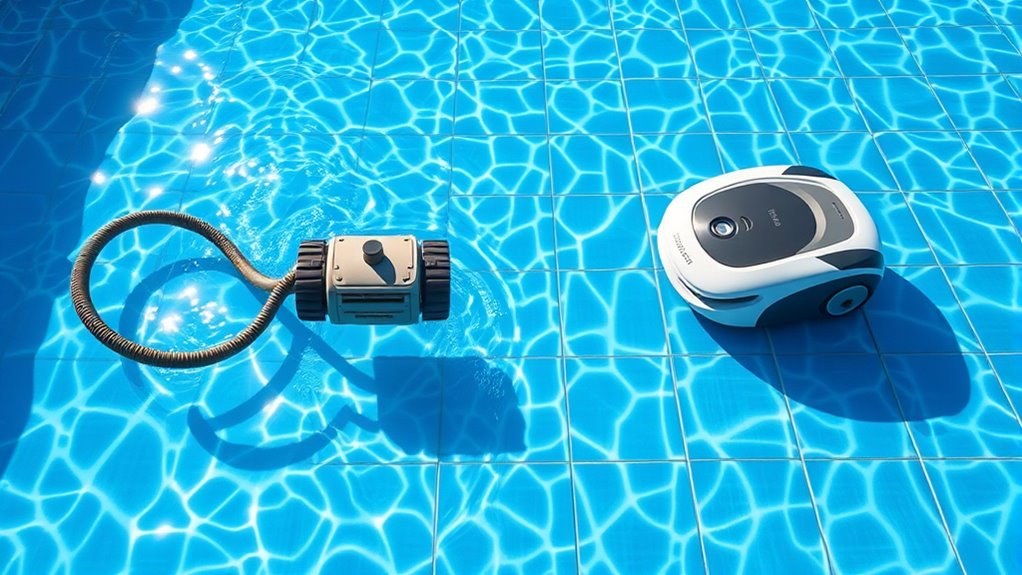
Pressure and robotic pool cleaners operate through different mechanisms, each designed to efficiently clean your pool. The cleaning mechanism of a pressure cleaner relies on water pressure, usually generated by your pool’s existing pump, to propel the cleaner and move it around the pool. Its power source is fundamentally the pool’s filtration system, making it simple to set up. In contrast, robotic pool cleaners have an onboard electrical power source, typically a cord connected to an external power supply. Their cleaning mechanism involves a motor that drives brushes and suction to remove debris. This independence from your pool’s filtration system allows robotic cleaners to operate more autonomously, covering the pool thoroughly. Both systems use distinct power sources to perform their cleaning functions effectively. Regularly assessing and maximize space and organization can help ensure your pool area remains tidy and functional. Additionally, understanding the differences in cleaning mechanisms can help you choose the best option for your pool’s specific needs, especially considering factors like energy efficiency and maintenance requirements. For example, robotic cleaners often feature programmable routes, which can optimize cleaning coverage and reduce energy consumption.
Efficiency and Coverage in Pool Cleaning

While both pressure and robotic pool cleaners are designed to keep your pool clean, their efficiency and coverage can vary considerably. Pressure cleaners often cover large areas quickly but may miss surface debris tucked into corners or along the walls. Robotic cleaners excel at thorough water filtration, targeting surfaces, steps, and tight spots more effectively. They typically have programmed routes, ensuring extensive coverage of the pool’s surfaces. Additionally, robotic cleaners are better at handling fine particles and small debris, thanks to their advanced filtration systems. This means you spend less time manually removing debris and more time enjoying your pool. Moreover, some robotic models incorporate automated navigation systems that adapt to different pool shapes, enhancing cleaning coverage. The inclusion of smart sensors allows these robots to detect dirty areas and focus their efforts accordingly. Advanced navigation systems contribute further to their efficiency by optimizing cleaning paths and reducing missed spots. Furthermore, robotic pool cleaners often feature programmable schedules, allowing users to set cleaning times that fit their routines, adding to their overall convenience. Many models also come with remote control options for manual operation when needed. Overall, robotic cleaners tend to be more efficient in providing complete coverage, especially for pools with complex shapes or heavy surface debris buildup.
Cost and Maintenance Considerations
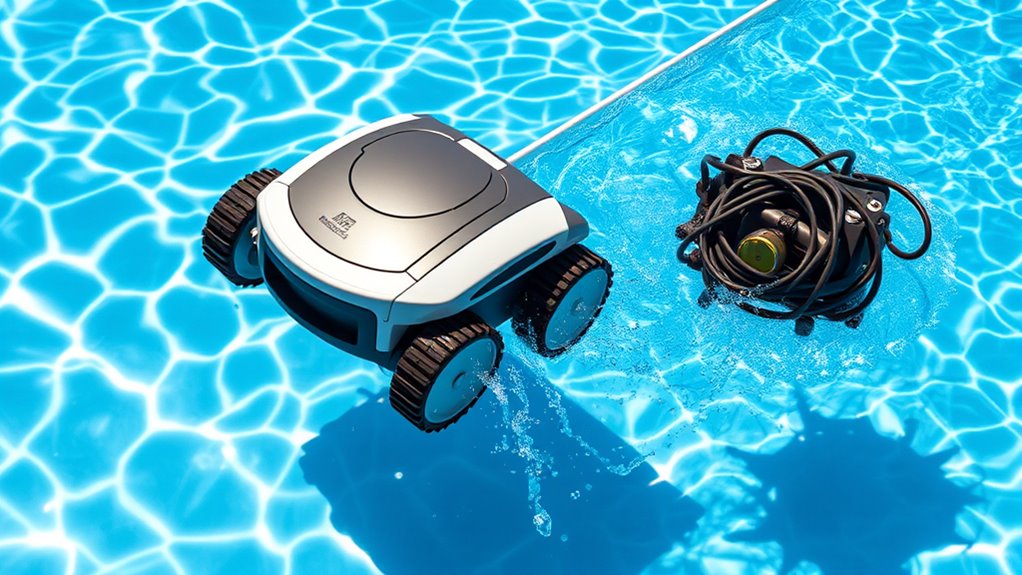
Robotic pool cleaners often come with higher upfront costs, but they can save you money over time through lower maintenance and energy expenses. Their water filtration systems are typically more efficient, reducing the need for frequent filter replacements. Plus, they tend to operate with quieter noise levels, making pool cleaning less disruptive. Maintenance involves occasional filter cleaning and checking for blockages, which is straightforward. Additionally, their friendly temperament makes them ideal for integrated pool care, enhancing overall maintenance ease. Regular use can also contribute to mindfulness by encouraging routine and attentive care of your pool environment. Considering the advanced technology involved, these cleaners are designed to simplify your pool maintenance routine and improve overall efficiency. Here’s a quick comparison:
| Aspect | Robotic Cleaner | Pressure Cleaner |
|---|---|---|
| Water Filtration | Advanced, easy to clean | Less efficient |
| Noise Levels | Quieter operation | Louder during use |
| Maintenance | Low, simple upkeep | More frequent, complex |
Ease of Use and Setup
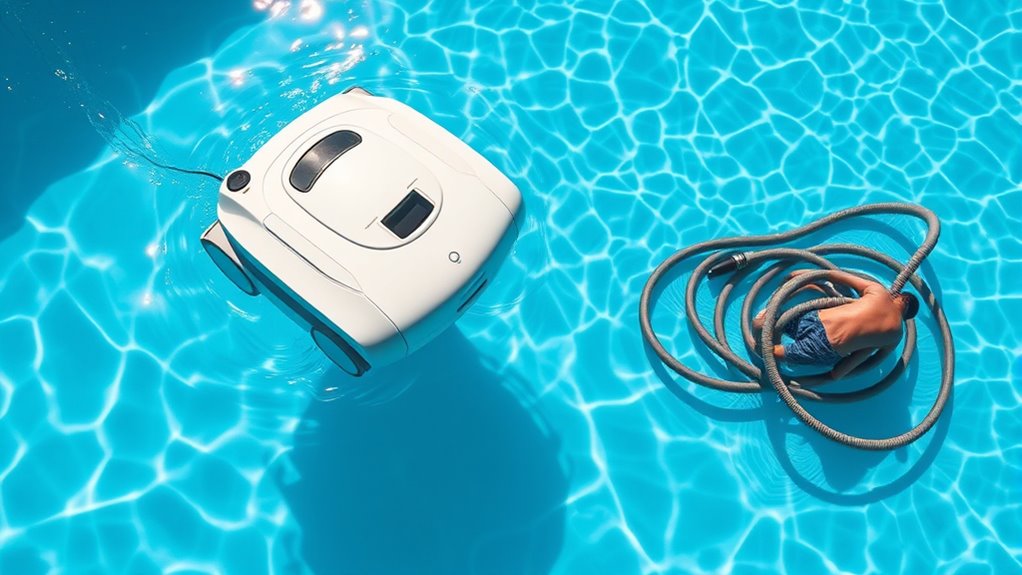
Setting up and using robotic pool cleaners is generally straightforward, making them accessible even for those new to pool maintenance. Their ease of installation means you can get started quickly without complicated steps. Most models come with clear instructions and minimal assembly required, enhancing user convenience. Once set up, operating these cleaners is simple; just power them on and let them do the work. Key points include:
Robotic pool cleaners are easy to set up and operate, making pool maintenance hassle-free for everyone.
- Plug-and-play design for quick setup
- Lightweight and portable for easy handling
- No hoses or additional equipment needed
- Automated cleaning cycles save time and effort
- Many models feature user-friendly controls that simplify operation, even for beginners. Additionally, their integration with automation technologies ensures seamless operation and monitoring. The durable construction and safety features, such as smooth edges, further contribute to a user-friendly experience. A minimal learning curve makes it easy for first-time users to operate robotic cleaners efficiently. This simplicity ensures you’ll spend less time on setup and more time enjoying your clean pool. Robotic cleaners are designed with user convenience at the forefront, making maintenance hassle-free. Moreover, compliance with safety standards provides added confidence in their safe use around pools.
Environmental Impact and Energy Consumption
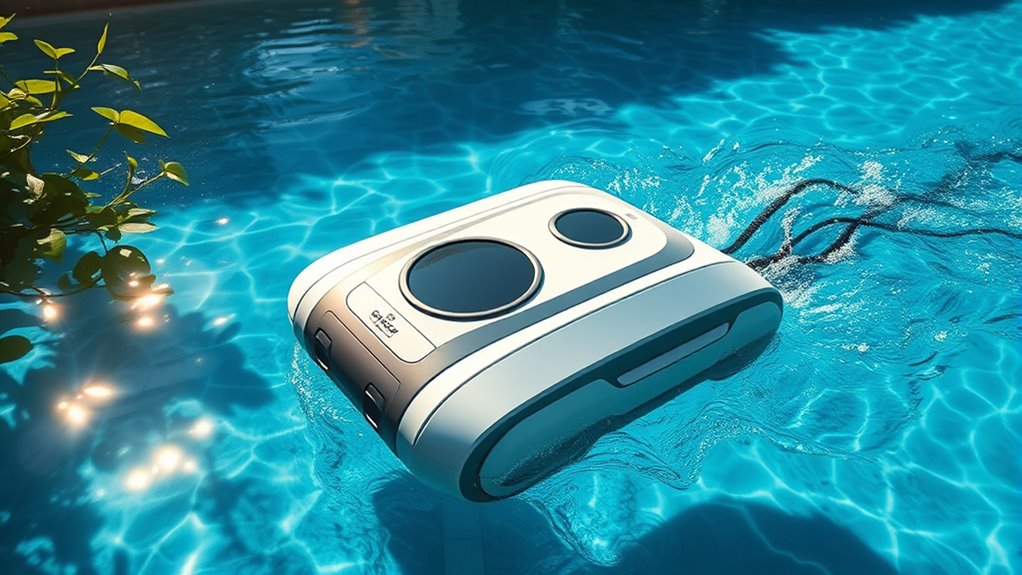
When choosing between pressure and robotic pool cleaners, you should consider their energy efficiency and how much power they use. You also need to think about how each type impacts your chemical use and waste production. You may want to evaluate the energy consumption of each model to determine which is more environmentally friendly. These factors can substantially affect your pool’s environmental footprint and your energy bills. Additionally, some models incorporate advanced hybrid scoring features that optimize cleaning performance while minimizing energy consumption. For example, Kia Tuning techniques can be applied to enhance the efficiency of your pool cleaner’s motor and components, similar to how Volkswagen Tuning improves engine performance and efficiency in vehicles. Understanding the preppy dog names that suit your pet can also influence your choice of equipment, as a well-named dog often reflects a personality that benefits from an efficient cleaning routine.
Energy Efficiency Comparison
Although pressure pool cleaners are often more affordable upfront, robotic pool cleaners tend to be more energy-efficient over time, reducing both environmental impact and operating costs. These cleaners use less power and often incorporate eco-friendly features like solar power, which can markedly cut energy consumption. Robotic models run independently of manual operation, optimizing cleaning cycles for efficiency. They also operate with minimal water and electricity, unlike pressure cleaners that rely on continuous pump use. Additionally, many robotic cleaners are compatible with different power sources, making them more adaptable to various energy options. Consider these points:
- Robotic cleaners consume less energy than pressure systems
- Some models utilize solar power, decreasing reliance on grid electricity
- Reduced water and power usage lowers environmental impact
- Less manual operation means more automatic, energy-efficient cleaning
Choosing a robotic cleaner helps you save energy, lowers costs, and supports eco-friendly practices.
Chemical and Waste Concerns
Robotic pool cleaners generally produce fewer chemical waste byproducts and have a smaller environmental footprint compared to pressure cleaners. Because they operate efficiently without relying on extensive chemical treatments, there’s less risk of chemical runoff contaminating nearby water sources. This reduces the chance of harmful substances leaching into the environment. Additionally, robotic cleaners generate minimal waste during operation, making waste disposal easier and more eco-friendly. They often use less water and chemicals for maintenance, further lowering their environmental impact. Conversely, pressure cleaners sometimes require more chemicals and generate more waste, especially when dealing with debris or chemical residues. By choosing a robotic cleaner, you contribute to healthier water management and reduce the ecological footprint associated with traditional pressure systems.
Ideal Pool Types and Sizes for Each Cleaner
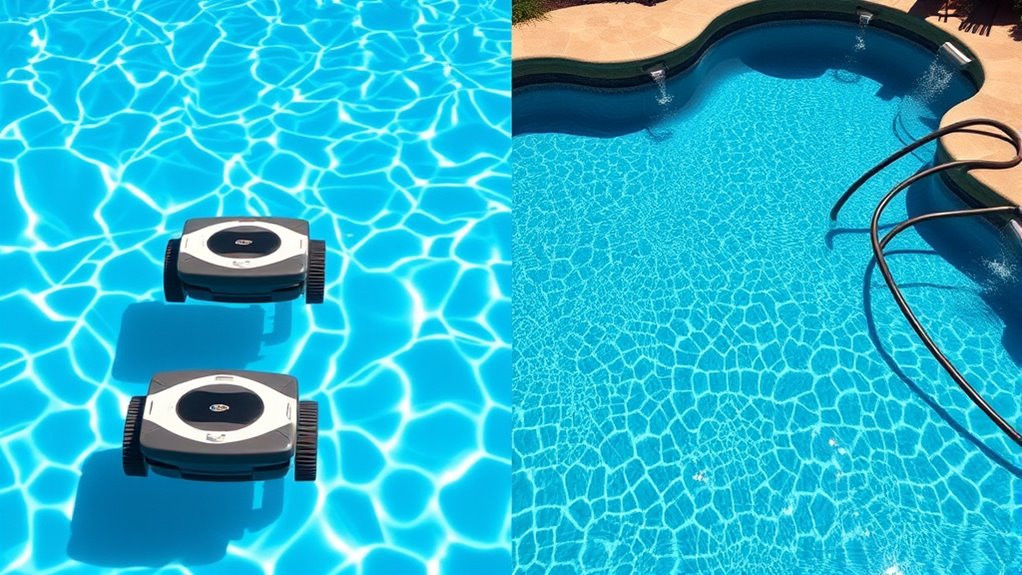
Choosing the right pool cleaner depends heavily on the size and shape of your pool. For smaller pools, robotic cleaners work well because they’re efficient and require less maintenance. Larger pools benefit from pressure cleaners that can handle extensive surface areas quickly. Consider your pool size and how often you plan to clean when selecting a cleaner.
- Small pools (up to 15 ft): robotic cleaners are ideal for frequent cleaning
- Medium pools (15–30 ft): pressure cleaners are effective for regular maintenance
- Large pools (over 30 ft): robotic models with longer run times work best
- High cleaning frequency: robotic cleaners reduce effort and time
Matching your pool size and cleaning frequency with the right cleaner ensures maximum performance and longevity.
Pros and Cons of Pressure and Robotic Pool Cleaners
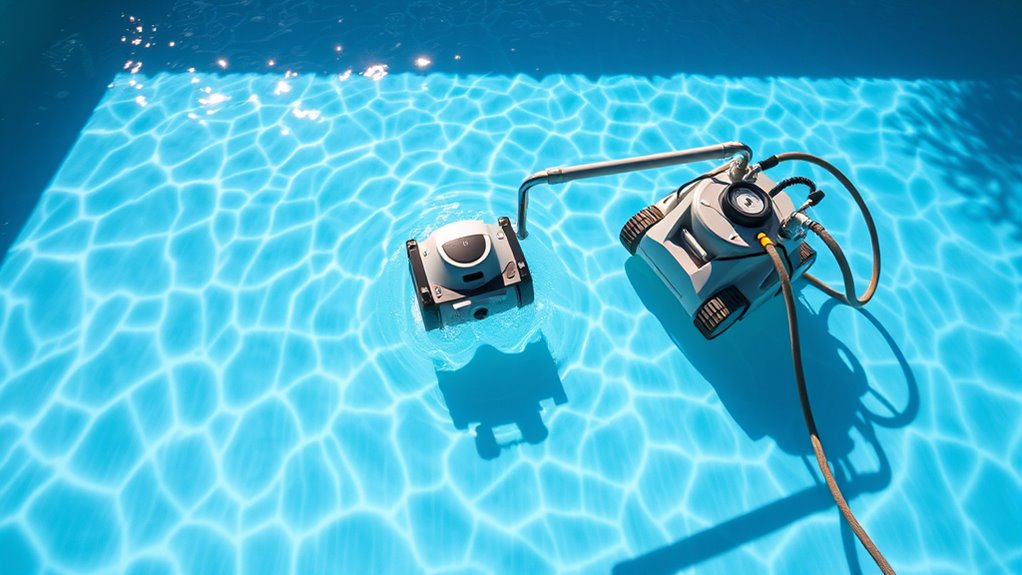
Pressure and robotic pool cleaners each have distinct advantages and disadvantages that can impact your pool maintenance routine. Pressure cleaners are effective at water circulation, helping to improve pool filtration by pushing debris toward skimmers. They’re generally more affordable and simple to operate but rely on hoses and pumps, which can limit maneuverability and efficiency in complex pools. Robotic cleaners, on the other hand, excel at thorough water circulation and cleaning, thanks to their independent motors and precise navigation. They often provide better debris removal and require less manual effort. However, they tend to be pricier and more complex to maintain. Your choice depends on your pool size, shape, and maintenance preferences, weighing the importance of cost, efficiency, and ease of use.
Frequently Asked Questions
Which Cleaner Is Better for Pools With Complex Shapes?
When it comes to pools with complex shapes, you need a cleaner that offers excellent cleaning efficiency and can navigate tricky corners. You might find that robotic pool cleaners are better suited for this task because they are designed to adapt to various pool layouts and reach difficult spots. This makes your pool maintenance easier and more thorough, ensuring every nook and cranny gets cleaned effectively.
How Long Does Each Type Typically Last?
You wonder how long each type of pool cleaner typically lasts. Robotic cleaners usually have a lifespan of 3 to 5 years, while pressure cleaners last about 5 to 7 years. Maintenance costs are generally lower for robotic units, thanks to fewer moving parts, and they’re more energy-efficient. Pressure cleaners might cost less upfront but can have higher ongoing maintenance costs and consume more energy over time.
Can Pressure and Robotic Cleaners Be Used Together?
They say two heads are better than one, and that applies here too. You can use pressure and robotic cleaners together for dual cleaning, which boosts maintenance efficiency. Combining both allows thorough debris removal and detailed scrubbing, saving you time and effort. Just guarantee they don’t interfere with each other’s operation, and you’ll get a cleaner pool faster, making your maintenance routine more effective and less stressful.
Are There Specific Brands Known for Durability?
When choosing a pool cleaner, you want to consider brand reliability and durability factors. Some brands are well-known for their durability, offering long-lasting products that withstand frequent use. You might look into brands like Zodiac, Dolphin, or Hayward, which have a reputation for quality and resilience. By selecting a trusted brand, you guarantee your pool cleaner performs efficiently over time, saving you money and hassle in the long run.
How Do Weather Conditions Affect Cleaner Performance?
Did you know that weather impact can reduce pool cleaner efficiency by up to 30%? Seasonal performance varies considerably, especially during heavy rain or strong winds, which can clog or displace cleaners. Cold temperatures may slow robotic models, while debris from storms can overwhelm pressure cleaners. To maintain ideal cleaning, adjust your equipment based on seasonal weather patterns, ensuring your pool stays clean regardless of weather fluctuations.
Conclusion
Choosing between pressure and robotic pool cleaners is like picking the right tool for your needs—you get to decide what fits best. Both have their strengths and quirks, so weigh your pool size, budget, and convenience. Think of it as finding your perfect dance partner—once you do, cleaning your pool becomes a breeze, turning a chore into a smooth swim. Plunge in confidently, knowing your pool will sparkle effortlessly!
